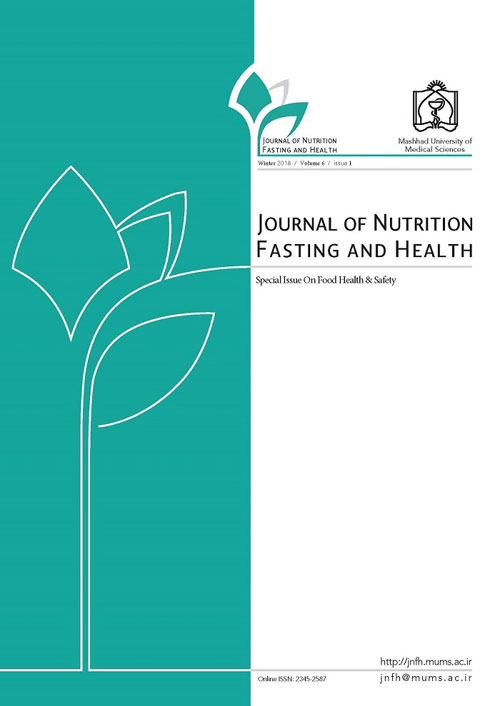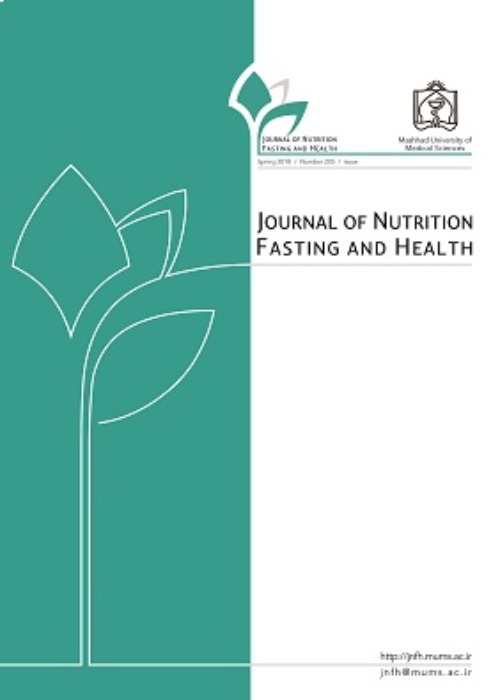فهرست مطالب

Journal of Nutrition, Fasting and Health
Volume:6 Issue: 1, Winter 2018
- special issue on Food Safety
- تاریخ انتشار: 1396/12/05
- تعداد عناوین: 8
-
-
Pages 1-6Background & ObjectivesThe implementation of pest control strategies is essential for reducing food waste and providing fresh safe food product. However, the excessive and uncontrolled usage of pesticides have caused serious environmental and health problems. The aim of this study was to evaluate the level of pesticide residues in food products in Iran via exploring the relevant published works.Materials and MethodsA comprehensive search was conducted through online databases such as PubMed, Google Scholar, Science direct and SID to identify the abstracts and titles of the relevant papers using English or Farsi keywords including ‘pesticide residues’, ‘Iran’ and ‘food’ or their Farsi equivalents.ResultsSo far, several studies have investigated the level of pesticides contamination in different foods and food materials in Iran, which the majority of them evaluated the foods of vegetal origin like cucumber, tomato, melon, etc. Different types of pesticides, including organophosphorus, pyrethroids and organochlorines, were assessed in those studies, where organochlorines were the main tested pesticides in foods of animal origin. According to this review, in some foods of vegetal and animal origin some illegal levels of pesticides can still be seen in different regions of the country.ConclusionAlthough the residues of pesticides in food material is an important issue, it seems that the national efforts for determination of those substances in different foodstuffs are inadequate. This indicates that the national food safety authorities and researchers need to be more serious about improving the present status regarding food application of pesticides.Keywords: Pesticide residues, Iran, Food
-
Pages 7-14IntroductionRaw meat is recognized as one of the most vulnerable foodstuffs. The present study aimed to assess the preservation of raw chicken hamburger coated with the blends of chitosan (CH) and gelatin (GE), activated with 1% cinnamon extract (CE) and stored in refrigerated conditions for 10 days.MethodsThe chicken hamburger samples (10 g) were aseptically cut and mixed in a stomacher with 90 milliliters of sterile buffered peptone water for two minutes. The proper dilution was inoculated onto microbiological plates, including Baird-Parker agar (Staphylococcus aureus), violet red bile glucose (VRBG) agar (total coliforms), and plate count agar (aerobic plate count (APC)). Peroxide value (PV) analysis was also performed based on standard method.ResultsOn sampling days zero, two, four, six, eight and ten, all the samples coated with edible films (especially those enriched with 1% CE) had excellent effectiveness against lipid oxidation compared to uncoated samples. After 10 days of storage, all the films could effectively decrease the growth of Staphylococcus aureus, total coliforms, and aerobic plate count (APC) in chicken hamburgers compared to controls (P<0.05).ConclusionIt could be concluded that edible bioactive packaging films containing CH- and GE-based polymers incorporated with 1% CE could be a proper alternative for improving chicken hamburger preservation.Keywords: Chitosan, Gelatin, Cinnamon extract, Chicken meat hamburger
-
Pages 15-22IntroductionListeria monocytogenes, Salmonella spp. and Staphylococcus aureus have been found in raw meat and meat products. The present study aimed to evaluate the effects of oregano extract(OE) at the concentrations of 0.1%, 0.2%, and 0.5%against Listeria monocytogenes, Salmonella typhimurium, and Staphylococcus aureus in raw beef meat during refrigerated storage (4±1ºC) for 10 days.MethodsIn this study, 10 grams of raw beef meat were added to 90 milliliters of sterile buffered peptone water and homogenized in a stomacher for two minutes. Proper decimal dilutions were prepared in buffered peptone water for microbial enumeration. S. typhimurium was cultured on Salmonella Shigella agar and incubated at the temperature of 37ºC for 24 hours. In addition, L. monocytogenes was cultured on PALCAM listeria-selective agar and incubated at the temperature of 30ºC for 48 hours, and S. aureus was cultured on Baird-Parker agar and incubated at the temperature of 37ºC for 48 hours.ResultsIn all the experiments, no growth was observed in L. monocytogenes, S. typhimurium, and S. aureus in the non-inoculated control samples. Antimicrobial effects were more significant at the higher concentrations of OE (P<0.05). Moreover, the addition of OEs to raw beef meat decreased the microbial counts of the tested pathogens during storage (P<0.05).ConclusionAccording to the results, utilization of OE in raw beef meat may be an effectivestrategy to assure safety against L. monocytogenes, S. typhimurium, and S. aureus. However, the associated sensory limitations do not allow the use of OE at higher concentrations, which are more effective in pathogen inhibition.Keywords: Oregano extract, Salmonella Typhimurium, Staphylococcus aureus, Listeria monocytogenes, Beef meat
-
Pages 23-29IntroductionAflatoxin contamination of agricultural crops leads to health hazards and detrimental to the economy. Despite enhanced processing, handling and storage, it remains an issue in the peanut industry. An effort was made to investigate the efficacy of corn zein coating combined with thymol and carvacrol as the edible coating may extend aflatoxinproduction.MethodsAnalysis of aflatoxins B1, B2 and total were performed for 11 treatments on coated and uncoated peanuts stored at room temperature for 90 days. Treatments were included zein, thymol (500, 1000, 1500 ppm), carvacrol (5000, 10000, 15000 ppm), incorporating thymol and carvacrol at three different concentrations and control.ResultsSignificant differences between coated and uncoated treatments were observed (p<0.05). The mean of aflatoxins B1, B2 and total in treatments with the highest concentration of antioxidant had increased between baseline and 90th day. While in other treatments the trend was decreasing compared to the control.ConclusionCoating containing zein showed the best results in terms of preventing aflatoxin formation. So it can be recommended as a suitable coating for peanut, promoting their health benefits.Keywords: Aflatoxins, Carvacrol, Peanut, Thymol, Zein
-
Pages 30-34IntroductionNon-standard food hygiene can lead to microbial contamination in food products. Foodborne pathogens can cause more than 200 illnesses from a mild diarrhea to cancer. Cream-filled pastries are milk-based bakery products with high production and consumption rate in confectioneries of Iran with soft and spongy texture made of different ingredients. The aim of this study was to determine microbial contamination of cream filled pastries as one of the high consumer acceptance product and to evaluate the relation between microbial contamination and sanitary conditions at Zanjan confectioneries.MethodsA total number of 62 cream filled pastries were collected from confectioneries of Zanjan city, Iran. Preparation, dilution and microbiological examination of samples were conducted according to the recommended instructions of Institute of Standards and Industrial Research of Iran, for total count enumeration, Escherichia coli, coliforms, Staphylococcus aureus, Salmonella, Bacillus cereus, Yeasts and moldswith No. 2395 and 8923-1, 2946, 2461, 6806, 1810, 2324 and 10899, respectively.ResultsMicrobial analysis showed that 40 specimens out of 62 samples had a total count out of the standard limit for cream-filled pastries. 20, 24, 4 and 47 samples had higher count than recommended limit of Iranian national standard for E. coli, S. aureus, Salmonella sp. and coliforms respectively. Thirty samples of cream-filled pastries had out of standard limit contamination with mold and yeasts.ConclusionResults showed low hygienic conditions of processing, storage and distribution of cream filled pastries. Therefore, respect to all essential principles of food hygiene by confectioneries from Zanjan, Iran is necessary.Keywords: Cream filled Pastries, Food borne pathogens, Iran, Microbial contamination, Zanjan
-
Pages 35-44Background & ObjectiveToday, the growing rate of soil contamination is a major environmental concern. The cohabitation between microorganisms and plants hasbeen in place for millions of years, and investigationsin this regardhave become an important research area.Materials and MethodsThe preset study aimed to assessthe effects of variousconcentrations of lead (0, 50, and 100 mg/l) and Trichodermaharzianumfungus (5%, 10% and 15%) on cauliflowerin a factorial design using fully randomized blocks in three replications under the climatic conditions of Dehlamavillage in Shahroud, Iran.The research was conducted during2014-2015 to measure the levels of chlorophyll a, chlorophyll b, totalchlorophyll, carotenoid, phenols, and flavonoids, as well as the antioxidant properties of cauliflower.ResultsThe results indicated that the highestlevels of chlorophyll a (75.723 mg/wet weight), chlorophyll b (27.378 mg/wet weight), and total chlorophyll (109.074 mg/wet weight) were associated with the interactive effects of the treatment with 5% Trichoderma and lead concentration of 0 mg/l. Furthermore, thehighest level of antioxidant properties (79.88% of free radicals) was associated with the interactive effects of lead at the concentration of 50 mg/l and treatment with 5% Trichoderma. The highest level of phenols (21.33 mg of Gaelic acid/dry weight) was associated with the interactive effects of the lead concentration of 100 mg/l and treatment with 5% Trichoderma and flavonoids(22.889 mg of quercetin/g/dry weight), as well as the interactive effects of the lead concentration of 50 mg/l and treatment with 5% Trichoderma.ConclusionSince carotenoids are antioxidants and precursors of vitamin A, the desired levels of antioxidants were achieved with the parallel effect of other antioxidants, such as total phenols and flavonoids.Keywords: Trichoderma harzianum, Brassica oleracea.Convar. botrytis L, Lead
-
Pages 45-51In this study, we searched the articles on determining the physico-chemical properties of sesame oil and heavy metals and aflatoxin whitout geographic restriction from the Google Scholar, PubMed, Science Direct and Sid databases and presented their results in the text. Characteristics such as iodine number and fatty acid profile of sesame oil indicate that this oil is highly unsaturated and the most important unsaturated fatty acids are oleic acid and linoleic acid and contains about 80 to 84 percent fatty acids in sesame oil. The main properties of sesame oil are resistance to oxidative damage, despite the fact that the unsaturated fatty acid content of this oil is high. Oxidative stability of sesame oil is due to the presence of gamma-tocopherol, lignans and antioxidants such as sesamol, sesamin and sesamolin. The amount total of aflatoxin in the studied articles was less than the EU limit (20 μg / kg), except studies of Amin et al. (2010), that total aflatoxin level was higher than the EU limit (20 μg / kg). In these studies, arsenic and lead levels below the limit set by the Union Europe (0.1 mg per kg). Also, the level of copper and iron was below the national standard level of Iran (0.4 and 5 mg / kg). Considering the desirable characteristics of sesame oil and its high degree unsaturation, In the case of heavy metals, aflatoxin is monitored continuously it is a suitable vegetable oil for human consumption.Keywords: Sesame oil, Physicochemical, Oxidative stability, Heavy metals, Aflatoxins
-
Pages 52-59Background & ObjectivesAcrylamide is a chemical compound that can form in some starchy foods, such as potatoes, bread, and products bakery during high-temperature (above 120°C) and cooking processes. This compound was identified by the International Agency for Research on Cancer as "a potential cancer-causing compound ". In this study, we discuss on how acrylamide can be generated from food components during heat treatment as a result of Maillard reaction between amino acids and reducing sugars.Materials and MethodsA comprehensive search was carried out in the following online databases such as Google Scholar, Science direct, PubMed and SID using English or Farsi keywords including acrylamide, and food.ResultsSince the acrylamide exists in food products, several reports on the presence of acrylamide in a range of fried and oven-cooked foods have caused worldwide concern since this compound has been classified as probably mutagenic and carcinogenic in humans. Several reports showed that asparagine, a main amino acid in potatoes and cereals, is a decisive contributor to the production of acrylamide through reducing sugars. Therefore, in this review, we searched on the formation ways of acrylamide and different methods to reduce and prevent its formation.ConclusionAccording to the nature of acrylamide toxicity and its risks to human health, as well as the importance of food safety and health issues, one or more methods can be used to provide the solution of reducing the rate of the formation of this harmful compound in susceptible products.Keywords: Acrylamide, Heated foodstuffs, Asparagine, Maillard reaction


